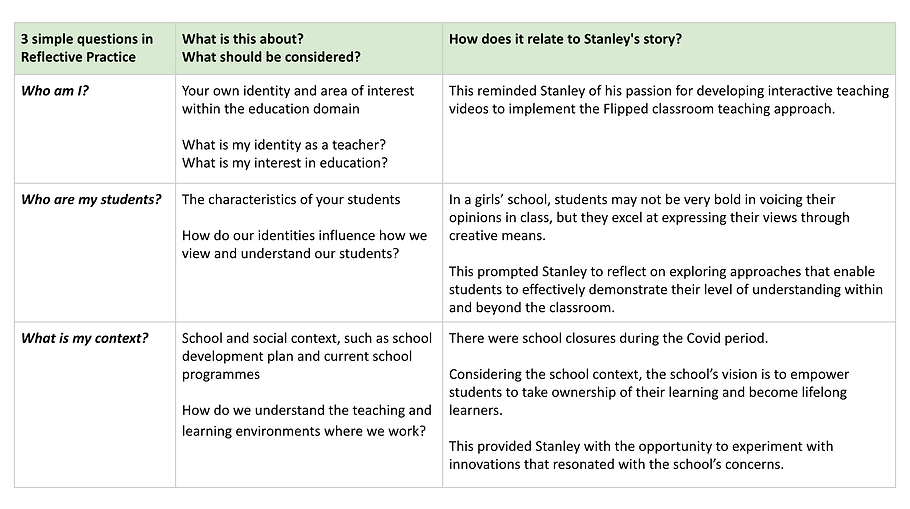
Envisioning Innovation in Education Stories
Stanley's Story
Stanley encourages colleagues to use reflective practice to review teaching practices and approach innovation in education:
Through Reflective Practice, we can consider what new strategies to develop at the opportune time, while taking into account students’ characteristics.
When promoting innovation in education, I encourage colleagues to consider their personal aspirations, students’ characteristics, and the challenges and opportunities in their own context.
This story illustrates
how you can approach innovation with/by…
Yourself
Use reflective practice to review practices
Colleagues
Leverage colleagues as resources and critical friends
Students
Empower students through voice and choice
About this EIE Story
This is the story of Stanley Mak, a Biology teacher from Marymount Secondary School (MSS). His story highlights the pursuit of educational innovation through reflective practice by asking, “Who am I?”, “Who are my students?” and “What is my context?”. His innovative efforts fostered greater student ownership of learning and encouraged visible thinking by actively listening to and valuing their voices and choices.
Key Highlights of this Story
MSS promotes six core values to students: Reverence, Gratitude, Compassion, Integrity, Perseverance, and Wisdom. The school offers a holistic education focusing on pastoral care and the school’s main concerns in 2023-2028 are as follows:
i) to enhance students’ well-being through building a greater sense of purpose in life
ii) to cultivate students’ ownership for them to be future-ready learners
During the EIE journey, the MSS team recognized the critical role of cultivating a culture of thinking. It is not only for student development, but also for teacher growth.
Stanley’s Picture of Practice:
In this story, Stanley shared his innovative approach to empowering students to become visible learners and thinkers. He emphasized the importance of giving students ownership over their learning and allowing them to progress at their own pace. He integrated playful elements to enhance student motivation and introduced Thinking Routines to facilitate structured expression of ideas.
Innovative teaching strategies featured in his story include:

Stanley developed a series of self-paced learning videos for Biology, incorporating Thinking Routines to assess students’ comprehension of various topics.

Form 3 students crafted comics to raise awareness about the causes and prevention methods of selected diseases among their peers.

Form 4 students used posters to narrate the story of a biologist and their discovery of biological diseases.

Form 5 students produced short videos to explain a selected Biology exam topic. Each student was required to offer feedback and suggestions on their peers’ work.

Form 6 students were tasked with designing multiple-choice questions and providing explanations, based on the format of public exams.
Frameworks, Concepts and Tools Learned from the EIE Experience
Reflective Practice
Reflective Practice can be described as the process of probing our identities, and understanding how our identities influence how we view and understand our students, as well as how we view and understand the teaching and learning environments where we work.
This serves as the guiding strategy for Stanley’s inquiry and innovation:

Thinking Routines
A Thinking Routine is a set of questions or a brief sequence of steps used to scaffold and support student thinking. Project Zero (PZ) researchers designed Thinking Routines to deepen students’ thinking and to help make that thinking “visible”. Thinking Routines help to reveal students’ thinking to the teacher and also help students themselves notice and name particular “thinking moves”, making those moves more apparent and transferable to other contexts.

Stanley integrated Thinking Routines into his series of self-paced learning videos, strategically placing them at various points in the videos to stimulate students’ thinking.
Thinking Routines he frequently used are:
Think, Puzzle, Explore: Activating prior knowledge, generates ideas and curiosity, and prepares students for deeper inquiry.
See, Think, Wonder: Encouraging students to make careful observations and thoughtful interpretations.
I used to think… Now I think… : Helping students to reflect on their thinking about a topic or issue and explore how and why their thinking has changed, as well as helps consolidate new learning
Pedagogy of Play
Pedagogy of Play framework supports playful learning through exploring the unknown, leading learning, and finding joy.
Playful elements have been incorporated into Stanley’s teaching strategies, such as tasking students with crafting comics, designing posters, producing short videos and setting multi-choice questions. These strategies aim to promote students’ autonomy and ownership in their learning, encourage curiosity, and foster joy and delight in the learning process.
Re-directing Authority
Re-directing Authority involves shifting the role of educators as sole knowledge holders and empowering students and other community members. It encourages students to actively use their individual and collective agency to enhance learning.
Assigning students to design exam multi-choice questions is an example of re-directing authority. This transition shifted the teacher’s role as an examiner to the students and empowered students to become more responsible for their learning. It also required students to demonstrate their understanding of the subject knowledge to fulfil this role, thereby enhancing the effectiveness of their learning.
Other Resources
Are you interested in exploring more relevant frameworks, concepts and tools? Click here to learn more!
